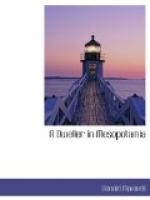How often does the unfortunate painter suffer from the well-meaning host, who with an admiration for his calling, which is both extremely flattering and tremendously inconvenient, tries to do him well—especially if he dabbles a little in water-colour painting himself. An organized attack on all the real or supposed picturesque bits in the neighbourhood is planned and the members of his family outdo each other in praiseworthy endeavours to help on the great cause of Art. The campaign is prefaced by a violent discussion at G.H.Q. as to the best landscape within easy reach, and Millie, who has had lessons in pastelles, prevails over Mollie, who merely does pen painting. The wretched painter is then hauled triumphantly into a car surrounded by the artistic, who regard him with almost heathen veneration and feel thrilled by the fact that they, too, observe that the sky is blue and the trees are green. Arriving at the chosen scene and viewing it from the spot “from which they always take it,” the unfortunate artist is stood or seated down, book in hand, complete with paintbox and water, and expected to begin. He does not have any voice in the choosing of the view. It is high noon. The sun is right in front of him and everything is so hard that even Turner could make nothing of it. The worshippers at the shrine of art stand round in awed anticipation, waiting for the masterpiece.
It is useless for him to protest that the conditions are impossible. “After such kindness that would be a dismal thing to do.” So he contrives to make some sort of a drawing which dims the lustre of his reputation in their eyes for many years to come.
[Illustration: ON THE EUPHRATES, EARLY MORNING]
The major took us in his car to various points along the river and explained the means employed in irrigation. On the Euphrates there are two methods used for local irrigation apart from the system of canals flowing from the river. One is the water-wheel, a curious contrivance built out on stone piers. It consists of a huge paddle-wheel with buckets like those of a dredger, that fills a trough that runs down into the fields.
The other is a water-raising device that is worked by bullocks. A large leather skin is hauled up from the river by a rope over a wheel. This rope is harnessed to a bullock which walks backwards and forwards hauling up the water-skin and letting it down again. When the full skin reaches the top it hits against a bar and pours itself out into a trough. These two systems, as can be easily imagined, are good only for the land in the immediate vicinity of the river bank, as the supply of water is necessarily not large. Above Hit the frequency of the water-wheels with their stone piers causes so much obstruction that navigation for any large boats is impossible. In one place there are seven wheels abreast.
At last we arrived at an old bridge crossing one of the ancient canals, which branched off from the river in a westerly direction. I have sketched it on page 57. It is extremely interesting as an example of the resuscitation of the old waterways of Babylonia. The banks of this channel here take almost a mountainous character for so flat a country. This piling up of mounds has been caused by clearing the silt from the entrance to the intake of the canal.




